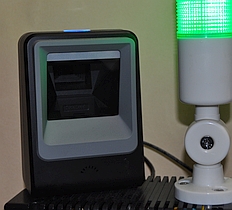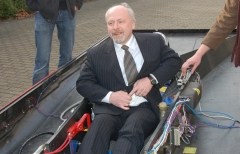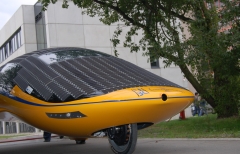One of our realtime process control project with Raspberry Pi and C shall be enhanced with a QR and bar code scanner for access and booking. The ID cards in question would contain only numbers. In hindsight, regarding the scanner chosen, this is sheer luck.
Choosing the approach
For “seeing” an object carrying a bar or QR code and decoding it on a PI one can
- fit one of the many Pi camera types to the Pi and use software to recognise and interpret the code
- use a stationary scanner doing all that connected via USB to the Pi
The fist approach was abandoned soon for a number of reasons:
- Distance and resolution would require the “expensive” (80..100€) and relatively bulky Pi camera type with extra objective. For that no acceptable casing and stand solution was found.
- For whatever reasons, software and libraries for bar code recognition, proven and easy to use, seem to be all in Python and none in C. This we could not do as the process control software and library and hence the rest of the incorporating project is in C; see this in publication
- Placing, testing and focusing the camera is hardly done in an OS with no graphics, i.e. in a “lite” Raspbian aka PiOS.
- As outlined in the above mentioned publication a none lite Raspbian is the death to all our real time requirements.
Hence we choose the second approach. 
The scanner
We ordered an Alacrity Handsfree 2D 1D Wired Barcode Scanner. Its a black box
with a viewing window standing solidly on the table. It is connected to and
supplied
by the Pi via USB 2. For 110€ you have no fiddling with camera stands,
objectives or stubborn flat cables.
The manual is not worth the name. Its more or less a collection of special
bar codes to change settings. Once you’ve lost, you never get back: No
download by supplier nor manufacturer.
On the other hand this box detects almost every code found in our household
in all positions, in many colours and art designs as well as on surfaces,
like cotton, paper, plastic, handy screens etc. And in most cases the loud
“victory beep” came very quickly.
So all seemed well – and is, but more by luck than understanding.
The interface
The scanner purchased acts as an USB PC keyboard with US key layout in the
factory configuration.
Pi’s raw interface to an USB keyboard is /dev/hidraw0. Enable it for a normal
program by:
sudo chmod a+=rw /dev/hidraw0
This will be lost when disconnected. Hence,
@reboot chmod a+=rw /dev/hidraw0
will only work when the connection is fixed.
On the opened raw keyboard interface
/dev/hidraw0
every read yields
8 bytes (all else is a fundamental error). These eight bytes are:
[0] shift bits, [1] error code, [2] 1st key pressed ... [5] 4th key pressed
As a QR code scanner in the guise of a keyboard will never press two or more keys at once and never will simulate an error 6 of those 8 bits will always be 0. This example shows the input for “AaB10”:
2, 0, 4=A, 0, 0, 0, 0, 0
2, 0, 4=a, 0, 0, 0, 0, 0
2, 0, 5=B, 0, 0, 0, 0, 0
0, 0, 0=, 0, 0, 0, 0, 0
0, 0, 30=1, 0, 0, 0, 0, 0
0, 0, 39=0, 0, 0, 0, 0, 0
The 2, by the way means “left shift”. This scanner, politely, only “presses” the left shift button. And “nothings” (shifted or not) can be interspersed at any place in any number. The purpose of those can only be speculated on.
Anyway, by providing two (a shifted and a non shifted) key number to key value lookup tables, you easily get the bar/QR code’s text. Just know the US American keyboard layout or explore its implementation by the Alacrity scanner.
The char set of the most ignoring people
As being German based and in a German project we, of course, would like to
read the names correctly, should they appear one day on the ID cards with
numbers mentioned above.
“Käte Nüßlein” should be “Käte Nüßlein” not “Kte Nlein” or
something totally gaga. Well, our the Alacrity Handsfree 2D 1D scanner can
be set to “German” by a special bar code; this setting won’t get lost at
power down.
Now we are faced with a solvable and a unsolvable problem. The solvable first:
In its stone age tradition a C char can’t handle anything but US ASCII in a portable manner. Hard core C programmers (in the past) considered a char’s bit 7 as a no cost boolean.
To handle the above to text translation you have to provide three
translation tables (a shifted and a non shifted and a
AltGr=right Alt one) and you have to use wchar_t (wide char) for those
look up tables. And you should know the German keyboard or explore it.
The most important information: z and y are now in the right
place, correcting the mistake renaming the perfume
“Oil of Olay” to “Oil of Olaz” in Germany.
With all those toils we don’t loose characters (many of them
changing places on the keyboard respectively look up tables).
We just got three [sic!] characters extra: ² ³ °.
We do not get: ä ö ü Ä Ö Ü ß § € µ.
They are completely lost; i.e. you don’t even get whatever key button message
over the USB line and, hence, no way around “Kte Nlein”.
It turns out the (probably) Chinese firmware writers do not
have even the vaguest notion of a German keyboard.
So recognising German text in QR codes is the unsolvable problem. So we switch back to factory setting and to the char set of the most ignoring people: US-ASCII.
As long as this restriction is not clearly communicated by the vendors, we
feel us within our rights to return the thing as soon as the detection of
the flaw. Imagine a German keyboard without Umlauts!
On the other hand – within its limitations for our current project task –
the little thing works reliably and fast and our C software is no
thread to the other real time programs running on the same Pi.
Comments
Want to leave a comment? Visit this post's issue page on GitHub.For commenting you will need a GitHub account.






